Physical
Attendance impacted by fatigue, nausea/vomiting
Potential mobility issues in the school
Susceptibility to infection
Social-emotional
Concerns related to body image, such as hair loss, limb loss, scars
Reduced opportunity to participate in school activities
Cognitive
Reduced attention/concentration related to physical illness
Absences
For children between the ages of five and 18, school is one of the largest components of their time. When children are diagnosed with cancer, however, treatment often significantly interferes with their participation at school. Depending on the type of treatment and side effects, children may experience significant disruption in both their social relationships at school and their academic education (Bruce et al. 2012; Gurney et al. 2009). Fatigue, nausea, vomiting, and immune compromise are specific issues that confront many children during treatment. Physical limitations to attendance are likely to be most pronounced shortly after diagnosis and in the initial stages of treatment. For example, one small study (Sullivan et al. 2001) found that patients missed between 27 and 170 days of school after diagnosis. Prevatt, Heffer, and Lowe (2000) reported that childhood cancer patients miss 40 days of school per year while in active treatment. Although treatments have evolved and more care is provided on an outpatient basis, there is limited information about current attendance rates of students in the United States while in active treatment. Disruptions to school attendance, however, also appear to persist after completion of treatment. In a study from Canada, French and colleagues (2013) studied absenteeism in survivors, 2 or more years after the end of treatment. Survivors missed significantly more days of school than the control group and averaged 11 absences per year, with 1.4 absences related to hospital visits, in comparison to an average of 5 absences per year for healthy controls in the school district. Moreover, absences were associated with difficulties with physical activity, pain, and energy level by patient report.
Moreover, it is important to be mindful of the impact of cumulative school absences. For children with frequent absences, a common response has been to consider grade retention. For example, Barrera et al. (2005) reported 21 % of a sample of childhood cancer survivors were retained versus 9 % in their control group. Research has suggested that grade retention may have some short-term benefit in academic performance, but this benefit disappears over time. Moreover, “social promotion” or the policy to advance a child to the next grade to maintain peer connections has also not been associated with long-term benefit (National Association of School Psychologists, Position Statement 2011). Rather, it is more important for education professionals to identify the child’s specific learning needs and find ways to provide the needed educational experiences.
When medically unable to attend school, educational needs can be addressed through individual tutoring, as well as hospital-based classrooms, where available. When children have prolonged absences from school due to medical needs, they can be eligible for tutoring services. It is important to know that there may be a minimum number of consecutive days the child must be absent before they are eligible for tutoring services. Another issue often raised with tutoring is the limited number of hours that are typically provided (Bessell 2001; Sullivan et al. 2001). Clinicians may need to think creatively and form collaborative relationships to help supplement educational instruction during treatment. For example, as described by Ortlieb (2008), it may be fruitful for medical centers to explore partnerships with nearby universities training teachers. As part of a practicum or preservice experience, student teachers may be paired with patients to provide additional instructional support, and students can receive additional teaching opportunities. Online and computer-based learning programs may be another resource to provide patients with greater access to educational material.
In addition to educational needs, children also have social needs related to school absences. For children who are not medically able to attend school, it is important to explore avenues to continue their sense of community with their classroom. This can be done by creating weekly newsletters that outline activities in the classroom; letters from classmates; use of technology, such as sharing Care pages or Skype sessions; or posting a picture of the child in the classroom (see Table 11.2). For example, Monkey In My Chair is a charitable organization that provides a stuffed “monkey” to hold the child’s place in the classroom, as well as an online portal that allows sharing of pictures and documents between the child and the classroom. In addition, Fox (2009) described the role of a laptop and webcam to help a homebound cancer patient “attend” class, with provision of a laptop and an agreement with the local telephone company for free home internet installation and a reduced service rate. There have also been several charities that have been created that can support these strategies by providing laptop computers to childhood cancer patients, such Hopecam (http://www.hopecam.org/) or Laptops of Love (http://laptopsoflove.com/). Moreover, there are also innovations exploring the use of technology to create a more interactive experience for the child, such as a remote-controlled robot that would allow the child to “move” within the school environment (see http://www.vgocom.com/remote-student). These connections to school are critically important as adolescents with a childhood-onset chronic illness who have a strong connection to their school have been found to be more likely to graduate from college (Maslow et al. 2012).
Table 11.2
Strategies for supporting social connections with school during active treatment
Develop a weekly newsletter outlining activities or lessons from the classroom |
Encourage students to write letters or draw pictures to share with the patient |
Videotape a class event to share with the student |
If feasible, identify a few students to visit the patient and deliver items from the class |
Explore the role of technology and social media to help keep the patient connected with the classroom (e.g., set up Skype session, have the classroom “Tweet” comments during the day, share the patient’s Care page with the classroom) |
Consider assigning reading selections or, for younger children, doing a read aloud, related to the patient’s cancer experience |
School Reintegration Programs
When the child is ready to return to the classroom, it can be helpful to plan and organize this transition. Clinicians from medical treatment centers need to form a collaborative relationship with the school community to help bridge the gap to the school (see Table 11.3). During this time, a 504 plan may be instituted to accommodate for some of these issues, such as a reduced class day or provision of an extra set of books to reduce the demands to carry heavy loads (see Table 11.4 for additional examples). In particular, it is important to work with school nurses to discuss and identify any medical needs the child might have at school, such as restrictions in activities, need for access to water, or notification of infectious illnesses in the school. Similarly, when a child returns to school, it is essential for the teacher to know and understand the child’s diagnosis, treatment, prognosis, and potential neurocognitive late effects (Gartin and Murdick 2009). Teachers often have to address and help students cope with absences, as well as maintain their academic progress and deal with potentially altered appearance (Best et al. 2005). See Fig. 11.1 for an example of an educational summary that can be used to help facilitate communication between medical providers and school personnel. Summaries of a child’s diagnosis, treatment, and educational needs should be shared with the school when the child is first returning to school. This would typically be shared with the “point person,” such as the school nurse or school psychologist, who is coordinating the child’s return to school. Parents may also choose to share it with teachers or other school-based personnel working with their child.
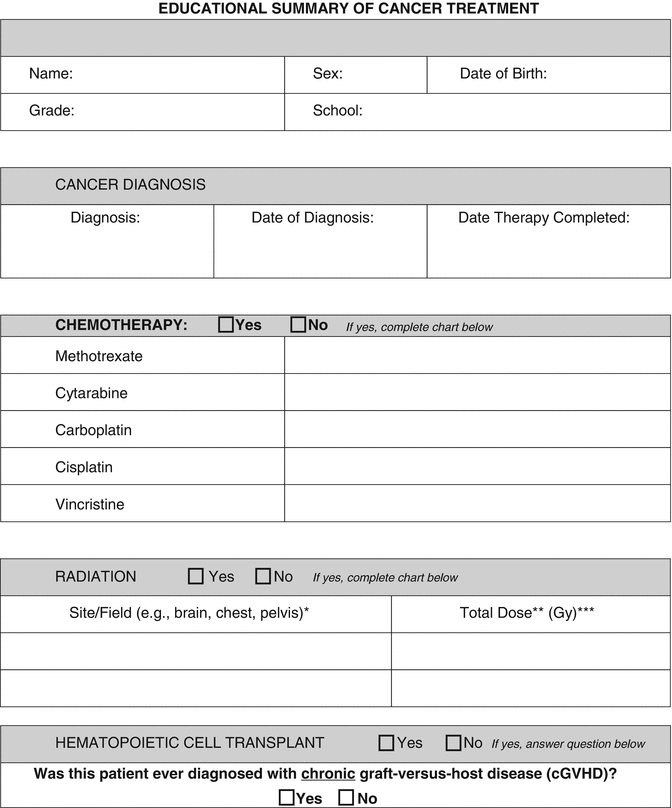
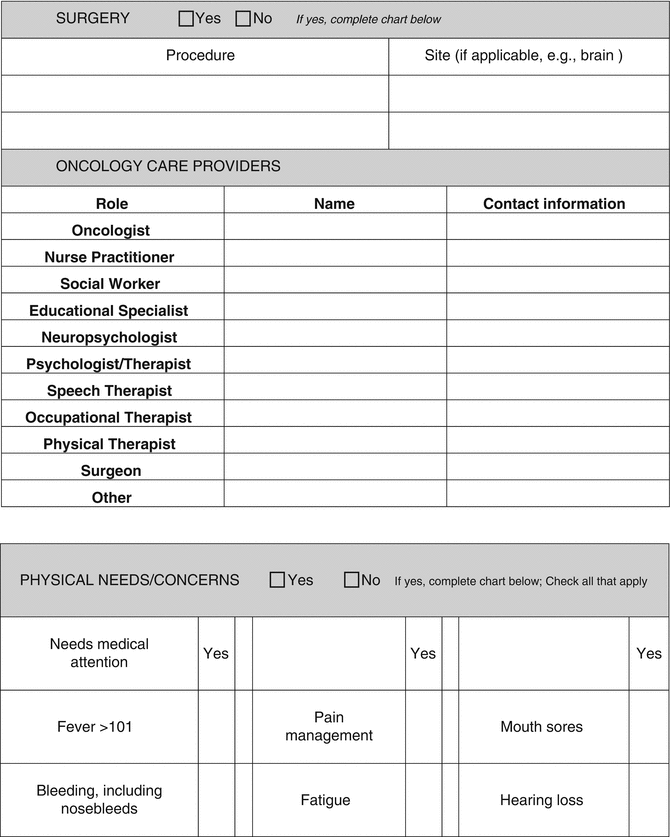
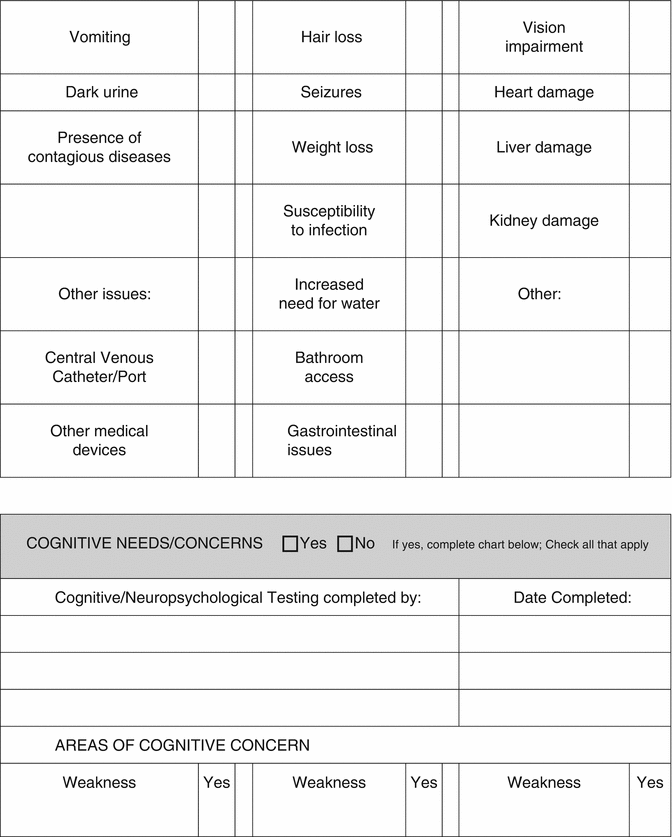
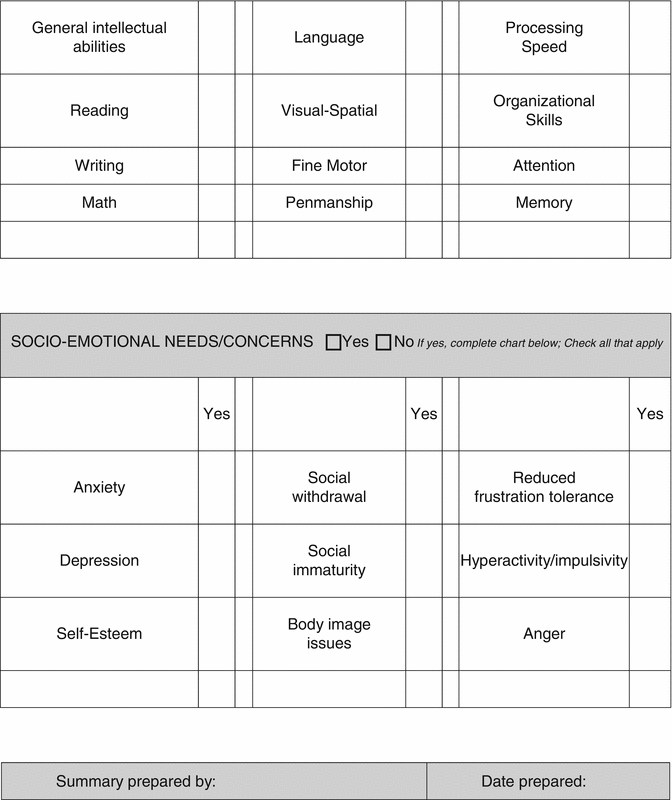
Table 11.3
Strategies to facilitate reentry to school
Identify a “point person” to act as a liaison between the medical and academic settings |
Develop brief reports or communication methods that can provide child-specific information related to disease, medications, restrictions on activities, “action plans,” and specific learning concerns |
When the student returns to the classroom, encourage the teacher to identify a peer that can help familiarize the patient with classroom routines and provide social support |
Help identify modifications that can be made to allow participation by the patient. For example, for a child with significant physical fatigue, encourage teachers to provide opportunities for peers to play cards or board games with the child during recess |
Try to structure clinic visits to minimize absences from school, such as consolidating and coordinating multiple specialty visits during 1 day |
If absences become excessive, assess for potential emotional, social, and family factors that may be contributing to school avoidance |
Table 11.4
Common accommodations during treatment
Provision of home-based tutoring |
Modified school day to address reduced endurance and fatigue |
Reduced homework, modified assignments |
Extended time for tests or classwork or projects |
Quick communication about communicable diseases in the classroom |
Permission to wear a hat or scarf to deal with hair loss |
Unrestricted access to water and/or the bathroom |
Early dismissal from class to provide extra time to navigate the hallways without peers present |
Provision of an extra set of books in order to eliminate the need to carry books from school to home |




Fig. 11.1
Educational summary of cancer treatment
In addition to identification of needed services and accommodations, a school re-integration plan typically includes supportive counseling for children and families, as well as an educational program for school personnel and/or peers and regular contact between the hospital and medical providers. Many hospitals utilize Child Life specialists, social work services, or psychology services to provide an educational session to the child’s class or school. This program is often tailored to the child’s developmental level and is created with input from the child and family. The primary focus of this session is to help educate peers and teachers, as well as decrease the “stigma” or fear that can be associated with childhood cancer. The process for developing a reentry program is presented in Table 11.5. Further details about reentry programs are described in Educating the Child with Cancer: A Guide for Parents and Teachers (2003) by the Candlelighters Childhood Cancer Foundation.
Table 11.5
Steps to develop a school reentry presentation
Obtain the child and family’s consent and input |
Determine the preferred audience (e.g., teachers, peers in classroom, peers from the grade) |
Determine if the child wants to be present and/or participate during the presentation |
Typical content areas will include: general information about cancer, specific information about the child’s type of cancer and its treatment, presence of a central line or port, other medical devices, any possible changes in appearance, any possible changes in behavior, what students can do to help support the child |
Review the content to be discussed and determine if there is anything the child does not want presented |
Review the plan with school personnel and identify a location for the presentation |
Provision of an organized education program directed towards teachers and peers has been helpful in facilitating school reentry (Leigh and Miles 2002). Although formal research is limited, studies of comprehensive school reintegration programs reported improvements in self-concept, interpersonal relationships, and behavioral functioning (Katz et al. 1988, 1992). In particular, Helms and colleagues (2014) conducted a meta-analysis of the six identified studies of school reentry programs and found benefit in academic achievement and reduced levels of depression, but there was not a significant improvement in social competence. Prevatt and colleagues (2000) identified characteristics of effective reintegration programs, including identification of a “point person” to coordinate services for the child with cancer, provide consultation between medical specialists to school personnel, and assist with school reentry education program for peers in the classroom.
Research has continued to examine potential essential components of school reentry programs, including greater attention to some of the social needs. As noted by Butler and Haser (2006), fear of peer rejection has been identified as the main reason children struggle to return to school. Individual research studies have suggested that school reentry programs with a social component are associated with reduced behavioral problems and improved sense of social competency (Barrera and Schulte 2009; Varni et al. 1993). Moreover, the Rehabilitation including Social and Physical activity and Education with Children and Teenagers with Cancer (RESPECT) was recently initiated in Denmark (Thorsteinnsson et al. 2013) to study the benefit of ambassador-facilitated educational, physical, and social interventions. A unique aspect of this program was to identify and develop two peer “ambassadors” who would not only share experiences from school with the patient but also join the patient in some of the hospital-based experiences, such as the hospital school program and hospital meals, in order to better understand the patient’s experience. The importance of developing peer supports is underscored in a qualitative study of five adolescents with a variety of cancers. Larouche and Chin-Peuckert (2006) noted teens reported a theme of using friends as “peer shields” to help them cope with body image issues related to treatment, with four of the five acknowledging that concerns about body image impacted their desire to return to school.
School Avoidance/School Refusal
For some children, a prolonged absence from school due to health-related needs can lead to school avoidance or school refusal. As conceptualized by Kearney (2008), school refusal can manifest as frequent absences, chronic tardiness, or generalized dread related to attending school. The presence of significant anxiety, particularly separation anxiety and generalized anxiety, as well as depression, can be a significant risk factor for school avoidance (Kearney and Albano 2004; Lyon and Cotler 2007). School refusal may serve to help children avoid situations that can elicit anxiety or depression, avoid social rejection, avoid evaluative situations, increase attention from others, and pursue other pleasurable activities, such as watching television or playing videogames (Kearney 2008). It is important to identify the specific factors for an individual child that are contributing to school avoidance behaviors in order to guide treatment; however, the primary treatment recommendation is to have the child return to school as soon as possible and avoid providing support for ongoing absences (Fremont 2003). Treatment can include child-directed cognitive-behavioral interventions, including relaxation training and exposure-based practice; parent-directed intervention, such as establishment of a contingency management system; and pharmacological treatments for underlying anxiety or depression (Kearney and Bensaheb 2006). In addition, it is important to provide increased social supports at school, address any potential underlying learning issues, and educate parents about the importance of regular school attendance.
Impact of Neurocognitive Late Effects
After completion of treatment, many family members and educators may feel that cancer is a thing of the past. Certain types of pediatric cancers and treatments, however, are associated with late effects, which emerge in the years following completion of treatment. These late effects include neurocognitive changes that are linked to educational issues, such as increased difficulty on school-related subjects (Spinelli 2003). As noted earlier, childhood cancer survivors are more likely to repeat a grade, receive special education services, and have lower overall educational attainment (Vance and Eiser 2002; Gerhardt et al. 2007; Moore et al. 2009). For example, as noted in a survey from the Childhood Cancer Survivor Study (CCSS), although the majority of survivors of a childhood CNS malignancy graduated from high school, they completed fewer years of education than their siblings (Ellenberg et al. 2009). In general, childhood cancer survivors are less likely to graduate from high school or attend college (Oeffinger et al. 2006; Mulrooney et al. 2008). In another study of a heterogeneous sample of childhood cancer survivors, 25 % qualified for special education services versus 8 % of a sibling control group (Mitby et al. 2003). Similarly, 23 % of childhood cancer survivors are reported to utilize special education services (Gorin and McAuliffe 2008). In addition, other research has suggested that 40–50 % of survivors of acute lymphoblastic leukemia (ALL) and up to 70–80 % of survivors of CNS malignancies will be eligible for special education services at some point (Nathan et al. 2007).
Risks and Related Features of Neurocognitive Late Effects
These educational outcomes are related to underlying cognitive changes that can emerge related to treatment effects. See Chap. 10 for a more in-depth discussion of neurocognitive late effects (NCLE). In general, research has reflected significant neurocognitive deficits, which are influenced by the type of cancer, treatment-related variables, and patient-related variables. For example, children with brain tumors are at greatest risk for NCLE, followed by children treated for leukemia and non-Hodgkin’s lymphoma. Similarly, cranial radiation treatment is associated with greater risk for cognitive change, followed by use of intrathecal chemotherapies. Younger age of diagnosis and female gender have also been identified as potential risk factors. For those that experience NCLE, specific neurocognitive weaknesses, such as greater reported difficulties in task efficiency, emotional regulation, and memory functioning, were associated with lower educational attainment (Ellenberg et al. 2009).
There have been several recent meta-analyses of neuropsychological sequelae of childhood cancer, often with additional educational endpoints. For example, Campbell and colleagues (2007) reviewed 28 empirical studies of children treated for acute lymphocytic leukemia. In general, survivors of leukemia had poorer performance across measures of intellect and academic skills in comparison to healthy or illness controls. Similarly, Peterson and colleagues (2008) conducted a meta-analysis of 13 studies of children treated with only chemotherapy without radiation for leukemia and found similar patterns of weaknesses in intellectual indices, as well as reading and math skills in comparison to controls.
Deficits were similar or larger when examined with children with brain tumors. As noted in a meta-analysis by Robinson et al. (2010) utilizing information from 39 empirical studies of 1,318 children with brain tumors from 1992 to 2009, there was a medium-to-large effect size in general intellectual abilities, with an accompanying, but smaller, effect size in academic. Another meta-analysis by de Ruiter et al. (2013) of 710 children with brain tumors reported in 29 studies from 1999 to 2011 found similar large effects for general intellectual abilities and visual-analytic skills. Scores were lower in association with treatment with cranial radiation, use of chemotherapy, and longer time since diagnosis.
Academically, math has generally been found to be the area of greatest weakness for childhood cancer survivors (Harshman et al. 2012; Barrera et al. 2005). In particular, children treated for ALL have also shown specific deficits in arithmetic (Brown et al. 1992). For children with posterior fossa brain tumors (Mabbott et al. 2005), there may be a greater range of educational weaknesses, and research has reflected reduced academic performance in spelling, reading, and mathematics.
Needs in the Schools
These educational issues present a unique challenge to educators and school personnel. Given the significant advances in treatment, there are an increasing number of childhood cancer survivors in school settings. It has been estimated that in a large high school, at any given time, there are likely two or three students who are childhood cancer survivors (Kadan-Lottick et al. 2010). Despite this increasing population, there is little research available related to school psychologists’ or teachers’ knowledge or needs related to working with childhood cancer survivors. An initial presentation of results of an anonymous survey of members of the National Association of School Psychologists (Trask and Faust 2011) examined issues related to school psychologists’ knowledge, training, and experience in dealing with NCLE. Based on 73 respondents from 27 states, school psychologists reported having very low levels of knowledge of NCLE and having very limited formal training about NCLE. Results suggested that treatment centers need to bridge the gap between hospital programs and the school community. For example, the Internet was rated as being the most frequently used source of information about NCLE for school psychologists, whereas physicians and nurses in medical centers were rated as being used less often. Information from the Internet was rated as being more easily accessed, generally more helpful, and equally as reliable as information gained from physicians and nurses. Similar to research with school psychologists, other research has reported that teachers do not rate themselves as knowledgeable about cancer and its treatment (Brown et al. 2011). This is an important endeavor, as other researchers (Nabors and Lehmkuhl 2004) have noted that improving teachers’ knowledge can empower them in their role teaching children with cancer.
Impact of NCLE on the Family
One of the challenges for a clinician is to determine the timing and focus of discussions with parents about potential neurocognitive late effects from cancer treatment. As noted by Trask and colleagues (2009) in a survey of parents of childhood cancer survivors, they have a high need for information about potential cognitive changes and their educational impact, both during treatment and after completion of treatment. Parents with higher levels of distress reported wanting to receive this information sooner and closer to the time of diagnosis. Nevertheless, there was still 12 % of the sample who did not want any additional information. Moreover, Zebrack and Isaacson (2012) noted that adolescent and young adult cancer patients have specific concerns about issues related to returning to school/work but vary significantly in the amount and type of information they wish to receive. In general, there continues to be a need for clinicians to be sensitive to and flexible in the timing of discussions related to the potential education impact of treatment.
For those children who develop NCLE, many also struggle with associated emotional distress or behavioral dysregulation (see Chap. 15 for review of psychological outcomes and quality of life), and it is important to recognize that these patterns of school difficulties, learning deficits, and cognitively mediated dysregulation symptoms can be extremely stressful for parents to manage. Many families report that management of their child’s cognitive and academic struggles leads to ongoing strain, as they find that they need to help their child with their work more, advocate for their child’s academic needs, explain to school personnel the details of NCLE, and sometimes carefully reconsider their child’s overall ability level and long-term potential. Research has supported the stress and burden that these parents typically report. For example, in childhood cancer survivors, the presence of executive weaknesses, particularly related to behavioral regulation, is related to increased parental stress (Patel et al. 2013). The ongoing behavior management and school advocacy demands on parents may result in increased and chronic strain for parents, and given the link between survivor academic difficulties and family conflict (Ach et al. 2013), it follows that NCLE likely have a broad effect on the entire family system of the survivor. Peterson and Drotar (2006) presented a family systems-based model illustrating how the childhood cancer survivor presents a pattern of NCLE and psychological difficulties, and these child characteristics interact in a dynamic and reciprocal manner with family factors, such as family functioning, caregiver burden, and caregiver psychological functioning (Peterson and Drotar 2006; see Fig. 11.2). These patterns of family functioning are also influenced by potential contributing factors, such as premorbid family functioning, responsiveness of the school, and the growth and development of the child over time. Therefore, it is important for clinicians providing long-term follow-up care to families to recognize the ongoing nature of how the survivor’s cognitive abilities and school difficulties may interact with parent stress and overall family strain, even long after the cancer itself is in remission.
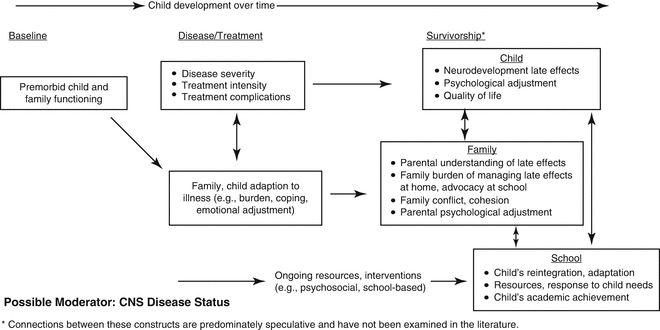

Fig. 11.2
Peterson and Drotar’s theorized integrated model of NCLE and family functioning in survivors of pediatric cancer (Peterson and Drotar, Clinical Child Psychology and Psychiatry, 11(3):352, copyright 2006. Reprinted by permission of SAGE)
Research from both the childhood cancer survivor population (Hocking et al. 2011; Patel et al. 2014a) and other pediatric populations (e.g., traumatic brain injury; Taylor et al. 1999) has indicated that family factors and parenting behaviors may actually influence the manifestation of the cognitive deficits in the child. For example, a family that is more cohesive and supportive of one another is more likely to be able to provide the supports and resources to help the child reintegrate into school successfully, advocate for appropriate services at school, and provide that child with the academic and emotional support to promote the best possible outcomes in the face of cognitive deficits. Considering the dynamic nature of the family system, however, it is also important to note that these patterns evolve over time, and the child’s abilities may play a strong predictive role in how the family adapts to the educational issues. For example, it may be that children with relatively stronger compensatory mechanisms and coping skills of their own are perhaps more likely to succeed in school, thereby reducing the overall sense of strain and caregiver burden placed on the family system. In sum, the child, family, and school personnel are regularly interacting over the course of many years in an effort to understand and successfully manage late effects of treatment in survivors throughout their academic and early employment career. It is therefore important to recognize that the severity, compensatory mechanisms, functional impairment, and accommodations of the NCLE can play a significant role in understanding how a survivor’s family continues to experience distress and burden long after active treatment has ended.
In addition to considering a family-focused approach to understanding the impact of NCLE, Peterson and Drotar’s family systems model (2006) can also be applied to understanding the potential for family-based or parenting-based interventions to ameliorate adverse outcomes for survivors. For example, Patel and colleagues (2014b) focused their intervention specifically on parent training to promote academic strategies and pro-learning behaviors in childhood cancer survivors with late effects and found some significant benefits for parent pro-learning behaviors and moderate effects on improving children’s academic outcomes. A clinical and research approach that considers the wide-ranging impact of NCLE on the families of survivors, as well as the survivors themselves, may lead to more targeted, effective interventions and ultimately may yield improved outcomes of interventions and other supportive services provided in long-term survivor care.
Identifying Children with Educational Needs
One of the challenges is to accurately and efficiently determine which survivors will need interventions or supports at school. The Children’s Oncology Group (COG) recommends that high-risk survivors be screened for neurocognitive weakness when they transition into a survivorship program, regardless of patient- or parent-reported concerns. COG also recommends that any survivor who has experienced prolonged school absences or who is experiencing school-related difficulties be evaluated, regardless of diagnosis or risk category (Nathan et al. 2007). In addition to an initial or baseline assessment, it has also been recommended that children treated for CNS cancer receive biennial comprehensive neuropsychological assessments (Armstrong and Briery 2004). Assessments should include measures of academic functioning, as well as measures of processing speed, attention, executive functions, memory, language, and visual abilities (Katz and Madan-Swain 2006). Also see Chap. 10 for recommendations related to assessments for neurocognitive late effects. In addition to neurocognitive weaknesses, childhood cancer survivors may also experience other late effects or associated side effects from treatment that can interfere with their participation and success at school, including hearing loss, vision impairment, fatigue, and motor coordination deficits. Specialized assessments by audiology, speech/language therapists, ophthalmology, and physical therapy may also be essential to understand the needs of childhood cancer survivors. The Association of Higher Education and Disability (AHEAD 2005) has identified seven elements which should be present in documentation of a disability evaluation in order to obtain supports while in higher education (See Table 11.6). Barriers to attainment of adequate neurocognitive assessment for survivors include a lack of adequately trained professionals, insurance limitations, and concerns from survivors and/or parents about being identified or “labeled” as having a special education need. In order to obtain needed assessment for survivors, clinicians should examine resources in their areas (see Table 11.7). Comprehensive neuropsychological assessments may be available at medical settings, as well as in private practice. For survivors who do not have access to neuropsychologists, school psychologists may be helpful, particularly for assessing academic issues and helping identify appropriate cognitive supports. Given concerns about the limited resources for assessment, as well as the increased use of computerized assessments for concussion management, there has also been interest in the use of computerized batteries to assist with screening childhood cancer survivors (Ullrich and Embry 2012). In addition to barriers related to access to professionals, concerns about the interpretation of assessments may also be a significant barrier. For example, Cheung and colleagues (2014), examining the implementation of recommendations provided in assessments, found that only 60 % of the families in their study actually shared a copy of the report with the school. This information is essential for school personnel if they are going to intervene with a child.
The credentials of the evaluator |
A diagnostic statement of disability |
A description of the methodology or procedure for assessment |
A description of functional limitations |
A description of the expected progress
Stay updated, free articles. Join our Telegram channel
Full access? Get Clinical Tree
 Get Clinical Tree app for offline access
Get Clinical Tree app for offline access

|